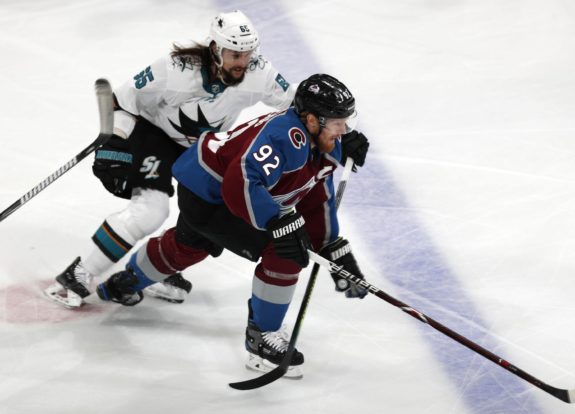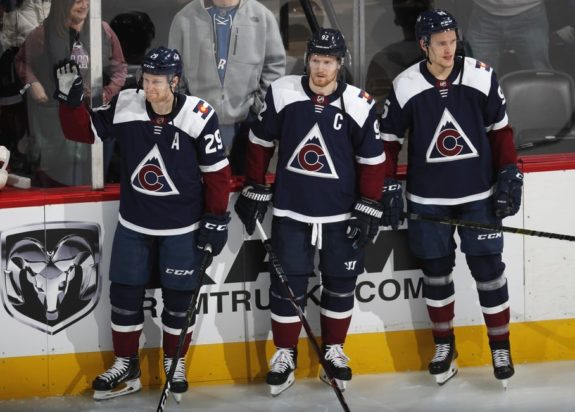The first road trip for the Colorado Avalanche wasn’t what they wanted it to be.
They split the four games – winning a game and losing a game against the Los Angeles Kings and Anaheim Ducks – but just four points in four games had to feel like a letdown against struggling competition.
The loss to the Kings was Los Angeles’ first win of the season and first in 316 days. In Anaheim, they lost a game where they completely outplayed the Ducks but won a game in overtime thanks to a bad pass from a goaltender followed by a spectacular play from their captain.
The Ducks had scored just six goals through the first four games of the season but rattled off five against Colorado over the weekend.

The Gabriel Landeskog goal was more than just a fantastic overtime winner. If the Avalanche lose that game and take only three points from the road trip, they would be tied for last place with the Arizona Coyotes. But, Colorado won that game, and it might be the saving grace from the always tough California swing.
With six points through six games, Colorado sits in the middle of a West Division logjam. They hope to get back on track – and get more consistency – as they return home tonight against the San Jose Sharks. But Colorado will have to change some ugly trends from the road trip to stretch a winning streak together.
Avs Need Help From Secondary Lines
One thing that has to happen is the offense has to get more diversified, as Colorado is the most top-heavy team in the West Division through the first six games of the season.
The top line comprised of Landeskog, Nathan MacKinnon, and Mikko Rantanen has accounted for 10 of the team’s 18 goals this season. No other top line from any of the other seven teams in the West Division has more than six goals.
That production is great, but the rest of Colorado’s forwards have combined for just six goals on the season. The bottom nine forwards on every other West team have combined for double-digit goals, except for Vegas (nine) and Anaheim (seven). Just eight different players have scored goals for Colorado on the season, which is the fewest of any West team besides Anaheim.
For context, the Ducks have been the worst offensive team in the West Division this season. They only have 11 total goals but have gotten them from seven different players.
Of the Avalanche’s six goals from its lower nine forwards, four came on the power play. Both of the goals scored during 5-on-5 play are from Joonas Donskoi. That’s simply not enough goals from not enough people.

All three of the players on the top line are averaging more than 20 minutes of ice time per game, but that leaves an average of roughly two periods per night where opposing teams have to worry about the threat of landing in the penalty box. When looking at it that way, suddenly, the time MacKinnon’s line is on the ice feels much more manageable for the opposing defense.
Not that coach Jared Bednar hasn’t been trying to spark things. He has used five different combinations on his second line and five different lineups on the third unit. The third and fourth lines got rattled around in the two games against the Kings, where Bednar rolled with only 11 forwards.
One main issue is the second and third lines need to flat out get the puck on target more. Colorado has put 180 shots on net, and more than a third of those (70) are from the top unit. Only once has the second line produced more than five shots on goal in a game, and the third line hasn’t had more than four on target in a game.
Late Inconsistency Plagued Road Trip
Hot starts haven’t been the problem for Colorado. They’ve scored first in every game except for one – Sunday’s 3-1 loss to Anaheim. They’ve also only given up three first-period goals all season, and two of those were in the season opener.
The problem has been hanging onto the leads. Colorado led by three goals in the opener of the road trip before hanging on to defeat L.A. 3-2. The Avs led 2-0 after the first period in the second game against the Kings but then gave up a pair of power play goals in the second before losing 4-2.
In Anaheim, the Avalanche led by a goal on two separate occasions before winning 3-2 in the extra session thanks to Landeskog.
In fact, Colorado has led in all three games it’s lost this season. Over the four-game road trip in California, the Avs allowed six goals in the third period, and five of those were at even strength.
The special teams have been sparkling. Colorado’s 10 power play goals on the season are easily the most in the league, and their 29 power play opportunities are second only to the 31 by the Vancouver Canucks. The penalty kill has also been great. Colorado’s opponents have just three power play goals on 22 attempts, and that 86.4 percent on the kill is top 10 in the NHL.

The power play is the one place where the top line isn’t doing all of the heavy lifting. Six different players have already scored with the man advantage in six games. MacKinnon and Rantanen both have two power play goals, but so do Devon Toews and Andre Burakovsky.
The Avalanche average 7:51 per game on the power play, which is third in the league. The problem isn’t when they have the man advantage – but when they don’t. For the other 52 minutes per game, over six games, Colorado has managed a total of only eight goals.
This comes back to getting more contribution from the lines below the top unit on the depth chart. The season is still young, but not as young as it looks. With just 56 games in the regular season, these six games equate to about nine in a regular 82-game schedule. The luxury of waiting for things to iron themselves out isn’t there this season.
With the expectations set for themselves before this campaign, the Avalanche likely didn’t plan on being in the middle of the pack – and just one point above last place – with a tenth of the season played.